What do I need to know before stocking?
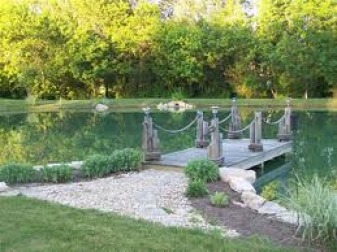
There are many factors when stocking your lake that can make or break your pond. Some combinations of fish work well, while others do not. If you're unsure about which fish to stock, feel free to call us and we will help set up your ideal pond or lake.
Water clarity, vegetation, cover, and depth all factor into your pond stocking. The more clear your water, the less reproduction you will get, due to predator fish being able to see further in your pond. Vegetation is very important to your pond; 10-20% vegetation is ideal because it gives prey fish a place to hide and multiply without making fishing a hassle. Although shallow ponds produce great fish, deeper ponds give different temperature and oxygen levels, providing more variation in the environment to suit their desire.
Water clarity, vegetation, cover, and depth all factor into your pond stocking. The more clear your water, the less reproduction you will get, due to predator fish being able to see further in your pond. Vegetation is very important to your pond; 10-20% vegetation is ideal because it gives prey fish a place to hide and multiply without making fishing a hassle. Although shallow ponds produce great fish, deeper ponds give different temperature and oxygen levels, providing more variation in the environment to suit their desire.
- Predator fish include Largemouth Bass, Smallmouth Bass, Hybrid Bluegill, Black Crappie, Walleye, Hybrid Striped Bass and Channel Catfish
- Prey fish include Fathead Minnows, Golden Shiners, White suckers, Bluegill, and Redear Sunfish.
- A typical growing season for our area is April to October.
- Fathead Minnows should always be stocked one growing season before predator fish are stocked.
- When stocking Largemouth Bass, regular Bluegill should be stocked one growing season before.
- The additional stocking of Golden Shiners helps turn your Bass into trophies.
- Bluegill, Hybrid Bluegill, Redear Sunfish, and Crappie are all types of Sunfish. Stocking more than 800 sunfish per acre is not recommended.
- Crappie should not be stocked in muddy or murky colored ponds, nor ponds that are not/ will not be stocked with Largemouth Bass.
Species of Fish
Channel Catfish
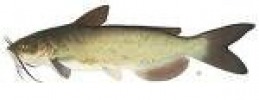
Channel Catfish (ictalurus punctatus) are a fast growing game fish that do well in the smallest pond to huge lakes. They are easy to catch in most conditions, put up a great fight, and a splendid to eat, making channel catfish one of the most popular fish in the world of stocking.
Channel Catfish are omnivores, meaning that they eat both plant and animal material. Their diet ranges from tiny algae and insects when young, to large fish at maturity. However, these fish do not play a large role in the balance of a pond. For the most part, Channel Catfish will eat the fish food that is fed to them and the weaker or wounded fish in your pond. Commercial fish food is the most significant way to put weight on your fish. Studies show that one to two pounds of fish food in an ideal environment will create one pound of flesh. When feeding your fish, throw some food out five to seven days after stocking (to give your fish time to settle down and adapt to their new home). If they eat it all in less than fifteen minutes, feed them more next time. If it takes your fish longer than fifteen minutes, cut the feed back. Catfish feed best in higher temperatures of water, feeding below a temperature of 65 degrees is not recommended.
Contrary to what most people believe, Channel Catfish often do not reproduce in your pond or lake. In the rare occurrence that they do, other fish in your pond typically eat them before they are big enough for you to see them. Catfish should be stocked at a rate of 100-500 fish per surface area of water, depending on how often you are going to feed them. Our Catfish are raised in ponds(not cages) and fed premium fish food twice daily through the growing season.
Stocking rates
100-500 per acre
Sizes avaialble Spring 2025
4-6 inch (appx 25 per pound)
6-8 inch (appx 10 per pound)
8-10 inch (appx 5 per pound)
10-12 inch (appx 3 per pound)
14 inch Plus (appx 1 per pound)
Channel Catfish are omnivores, meaning that they eat both plant and animal material. Their diet ranges from tiny algae and insects when young, to large fish at maturity. However, these fish do not play a large role in the balance of a pond. For the most part, Channel Catfish will eat the fish food that is fed to them and the weaker or wounded fish in your pond. Commercial fish food is the most significant way to put weight on your fish. Studies show that one to two pounds of fish food in an ideal environment will create one pound of flesh. When feeding your fish, throw some food out five to seven days after stocking (to give your fish time to settle down and adapt to their new home). If they eat it all in less than fifteen minutes, feed them more next time. If it takes your fish longer than fifteen minutes, cut the feed back. Catfish feed best in higher temperatures of water, feeding below a temperature of 65 degrees is not recommended.
Contrary to what most people believe, Channel Catfish often do not reproduce in your pond or lake. In the rare occurrence that they do, other fish in your pond typically eat them before they are big enough for you to see them. Catfish should be stocked at a rate of 100-500 fish per surface area of water, depending on how often you are going to feed them. Our Catfish are raised in ponds(not cages) and fed premium fish food twice daily through the growing season.
Stocking rates
100-500 per acre
Sizes avaialble Spring 2025
4-6 inch (appx 25 per pound)
6-8 inch (appx 10 per pound)
8-10 inch (appx 5 per pound)
10-12 inch (appx 3 per pound)
14 inch Plus (appx 1 per pound)
Albino Channel Catfish
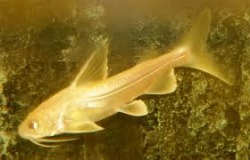
The Albino Channel Catfish is the exact same as Channel Catfish, with the exception of its white/pink skin. Growing, feeding, and stocking rates are the same as regular Channel Catfish. Keep in mind that predation is sometimes high in albino catfish due to predators (birds otters ect) being able to spot them easier.
Stocking rates
100-500 per acre
Projected sizes available Fall 2025 (currently unavailable for Spring 2025)
4-6 inch (appx 25 per pound)
Hybrid Bluegill
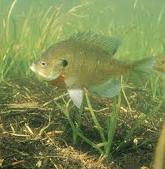
Hybrid Bluegill (sometimes referred to as Hybrid Sunfish) are not a true species of fish. In Fact, they are a cross of two other fish within the same sub species. Hybrid Bluegill are a cross of a male Bluegill (shown below) and a female Green Sunfish.
Hybrid Bluegill have huge advantages and a few drawbacks in your pond. They have the length and height of a regular Bluegill and the width and larger mouth of the Green Sunfish. They are very aggressive, making them an easier catch. They feed very well of a commercial fish food diet, giving them a large growing advantage over regular Bluegill. When fed a commercial diet, hybrids grow up to 16" long and weigh up to 3 pounds. Although some say hybrids are sterile, they are not. 90% of Hybrid Bluegill are male, making the likelihood of reproduction almost zero. These fish cannot be counted on to reproduce.
Stocking rate
100-500 per surface acre
Sizes available Spring 2025
1-2 inch (appx 100 per pound)
2-3 inch (appx 50 per pound)
3-4 inch (appx 30 per pound)
4-5 inch (appx 20 per pound)
5-6 inch (appx 10 per pound)
Hybrid Bluegill have huge advantages and a few drawbacks in your pond. They have the length and height of a regular Bluegill and the width and larger mouth of the Green Sunfish. They are very aggressive, making them an easier catch. They feed very well of a commercial fish food diet, giving them a large growing advantage over regular Bluegill. When fed a commercial diet, hybrids grow up to 16" long and weigh up to 3 pounds. Although some say hybrids are sterile, they are not. 90% of Hybrid Bluegill are male, making the likelihood of reproduction almost zero. These fish cannot be counted on to reproduce.
Stocking rate
100-500 per surface acre
Sizes available Spring 2025
1-2 inch (appx 100 per pound)
2-3 inch (appx 50 per pound)
3-4 inch (appx 30 per pound)
4-5 inch (appx 20 per pound)
5-6 inch (appx 10 per pound)
Bluegill
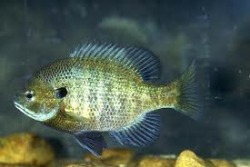
Bluegill (Lepomis Maciochirus) are a game/forage fish, essential to most ponds. They can reach a size of one pound and 14" long, but average 1/4-1/2 pound and 7-9" long. Bluegill provide food for other fish like Large Mouth Bass and the occasional mature Channel Catfish. They are a game fish that is fun to catch and great to eat. Bluegill feed on tiny algae like plankton, insects, and small fish such as Fathead Minnows. Some will eat commercial fish food, but it is not a normal diet for them due to their small mouths.
Bluegill are a near essential element for the growth of trophy Bass. Bluegill, when stocked, are usually two years old. Most Bluegill are sexually mature at that age, so reproduction is almost instant. They build nests on almost every type of pond, bank, or bottom, although sand or gravel is preferred. The nest are usually one to three feet beneath the water's surface when the water reaches 70-75 degrees. The lay between 2,000 and 70,000 eggs in each spawn, although the average is 15,000. Almost every fish in your pond will prey on their offspring, which it nature's way of keeping them around.
Stocking rates
100-1000 per acre
Sizes available Spring 2025
1-2 inch (appx 100 per pound)
2-3 inch (appx 50 per pound)
3-4 inch (appx 30 per pound)
4-5 inch (appx 20 per pound)
5-6 inch (appx 10 per pound)
6 inch plus (appx 6 per pound)
Bluegill are a near essential element for the growth of trophy Bass. Bluegill, when stocked, are usually two years old. Most Bluegill are sexually mature at that age, so reproduction is almost instant. They build nests on almost every type of pond, bank, or bottom, although sand or gravel is preferred. The nest are usually one to three feet beneath the water's surface when the water reaches 70-75 degrees. The lay between 2,000 and 70,000 eggs in each spawn, although the average is 15,000. Almost every fish in your pond will prey on their offspring, which it nature's way of keeping them around.
Stocking rates
100-1000 per acre
Sizes available Spring 2025
1-2 inch (appx 100 per pound)
2-3 inch (appx 50 per pound)
3-4 inch (appx 30 per pound)
4-5 inch (appx 20 per pound)
5-6 inch (appx 10 per pound)
6 inch plus (appx 6 per pound)
Black Crappie
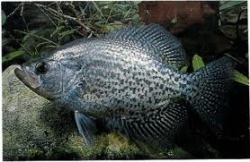
Black Crappie (Pomoxis nigromaculatus) are a sport fish that most anglers claim to be the best tasting fish in the water. Crappie can grow up to five pounds and 18" long. They spawn in early Spring, right on the bank and very close to the surface of the water. This makes them an easy catch during April and May.
Black Crappie are well loved in the world of fishing, but can pose problems in small ponds. One or two things usually occur. They may live to maturity with very little reproduction OR reproduce well and survive in great numbers with very little growth.
Black Crappie generally reproduce earlier in the season than Bluegill and Bass, giving them a huge jump in the food chain. They reproduce so many at a time and in cooler waters (fish are far less active in cool water than in warm water) that the other predator fish do not get enough eaten up before the Crappie fri eat up most of the plankton in the water. This affects the growth of other fish in your pond.
We do not recommend the stocking of Crappie in small ponds unless the following conditions are met:
Stocking rates
50-200 per acre
Sizes available Spring 2025
1-2 inch (appx 100 per pound)
2-3 inch (appx 50 per pound)
3-4 inch (appx 30 per pound)
4-5 inch (appx 20 per pound)
5-6 inch (appx 10 per pound)
6 inch plus (appx 6 per pound)
Black Crappie are well loved in the world of fishing, but can pose problems in small ponds. One or two things usually occur. They may live to maturity with very little reproduction OR reproduce well and survive in great numbers with very little growth.
Black Crappie generally reproduce earlier in the season than Bluegill and Bass, giving them a huge jump in the food chain. They reproduce so many at a time and in cooler waters (fish are far less active in cool water than in warm water) that the other predator fish do not get enough eaten up before the Crappie fri eat up most of the plankton in the water. This affects the growth of other fish in your pond.
We do not recommend the stocking of Crappie in small ponds unless the following conditions are met:
- Clear Water. The clearer your water is, the further you can see- making it easy for predator fish and see and eat the offspring of your crappie.
- Rooted vegetation. Rooted vegetation around your shoreline gives excellent hiding spots to spawn for small Fathead Minnows and leaves more food for your adolescent Bass. This also adds oxygen to your pond, making your fish more aggressive.
- Fathead Minnows. The stocking of Fatheads is essential for almost every pond. They reproduce quickly- sometimes three to four times per year. This gives other predator fish plenty to eat when plankton levels are low.
- Large Mouth Bass. Without Large Mouth Bass in your pond, Crappie overtake the pond. Other predator fish are necessary to keep the Crappie count at bay. Crappie have a tendency to reproduce until the food source is gone, giving you a pond of small, unacceptable Crappie.
Stocking rates
50-200 per acre
Sizes available Spring 2025
1-2 inch (appx 100 per pound)
2-3 inch (appx 50 per pound)
3-4 inch (appx 30 per pound)
4-5 inch (appx 20 per pound)
5-6 inch (appx 10 per pound)
6 inch plus (appx 6 per pound)
Redear Sunfish
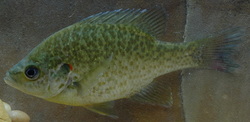
Redear Sunfish (Lepomis microlophus) are also known as the Shell Cracker. Redear help control worms in ponds. Anyone who fishes in the heat of the summer has seen a worm or two in the meat, fins, or skin, of a fish. These are tapeworms, yellow grubs, white grubs, or black grubs. Redear are not big competitors of other fish; they have a diet of aquatic animal life that other fish usually do not prey on. The consumption of snails is the main reason they get grubs.
Redear Sunfish, despite their feeding habits, still grow to great sizes. The record is 5 pounds, but they average 1 pound and 12-14" long. They have very white and tasty meat and are a fun catch. Redear are bottom feeders and can be challenging to catch, very rarely feeding at the top of the water. They do not eat commercial fish food, making them difficult for fish farmers. Sole reliance of nature for your fish to grow means that getting these fish to size can be very challenging. Sizes and availability are limited on these fish.
Stocking rates
100-300 per acre
Sizes available Spring 2025
1-2 inch (appx 100 per pound)
2-3 inch (appx 50 per pound)
3-4 inch (appx 30 per pound)
Redear Sunfish, despite their feeding habits, still grow to great sizes. The record is 5 pounds, but they average 1 pound and 12-14" long. They have very white and tasty meat and are a fun catch. Redear are bottom feeders and can be challenging to catch, very rarely feeding at the top of the water. They do not eat commercial fish food, making them difficult for fish farmers. Sole reliance of nature for your fish to grow means that getting these fish to size can be very challenging. Sizes and availability are limited on these fish.
Stocking rates
100-300 per acre
Sizes available Spring 2025
1-2 inch (appx 100 per pound)
2-3 inch (appx 50 per pound)
3-4 inch (appx 30 per pound)
Large Mouth Bass
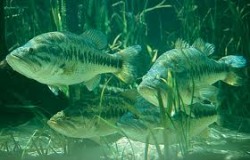
Large Mouth Bass (Micropterus salmoides) are known as the highest trophies in the United States fishing industry. Tournaments are hosted in every state of the union. Bass are grown to near record size in the smallest of ponds to the largest of lakes.
Bass grow very rapidly when food is plentiful. A 3-4" Bass can reach sizes of 8-10" in one growing season and up to 16" in three. In the second year, Bass usually become sexually mature. Spawning begins in late May to mid-June. Eggs take longer to hatch than other species and their offspring and weak in early weeks. A 10 degree drop in water temperature can Kill of large numbers of your Bass fry.
Bass are very strong predators and eat a lot of food to maintain health. It takes 6-8 pounds of food for a Bass to gain one pound. You should first stock Fathead Minnows and Regular Bluegill one full growing season (April to September) prior to stocking Bass. This gives Bluegill time to reproduce from 100's to 1,000's tan the minnows from 1000's to tens of 1000's. This makes your pond a smorgasbord of tasty, high protein food.
Stocking rates
100 per acre
Sizes available Spring 2025
3-4 inch (appx 70 per pound)
4-5 inch (appx 20 per pound)
6-8 inch (appx 10 per pound)
8-10 inch plus (appx 5 per pound)
12 inch plus (appx 1 per pound)
Bass grow very rapidly when food is plentiful. A 3-4" Bass can reach sizes of 8-10" in one growing season and up to 16" in three. In the second year, Bass usually become sexually mature. Spawning begins in late May to mid-June. Eggs take longer to hatch than other species and their offspring and weak in early weeks. A 10 degree drop in water temperature can Kill of large numbers of your Bass fry.
Bass are very strong predators and eat a lot of food to maintain health. It takes 6-8 pounds of food for a Bass to gain one pound. You should first stock Fathead Minnows and Regular Bluegill one full growing season (April to September) prior to stocking Bass. This gives Bluegill time to reproduce from 100's to 1,000's tan the minnows from 1000's to tens of 1000's. This makes your pond a smorgasbord of tasty, high protein food.
Stocking rates
100 per acre
Sizes available Spring 2025
3-4 inch (appx 70 per pound)
4-5 inch (appx 20 per pound)
6-8 inch (appx 10 per pound)
8-10 inch plus (appx 5 per pound)
12 inch plus (appx 1 per pound)
Yellow Perch
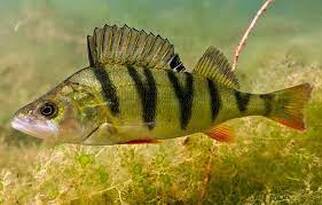
The yellow perch, commonly referred to as perch, striped perch, American perch, American river perch or preacher is a freshwater perciform fish native to much of North America. In many populations, yellow perch often live 9 to 10 years, with adults generally ranging from 4 to 10 inches in length with some exceeding 15 inches. Perch spawn in early spring before most everything else in your pond. Survival of offspring is fair in ponds with largemouth bass populations. They prefer tree branches for spawning over beds like most fish. Yellow Perch can be stocked in all waters over 6 feet deep. Additional fathead minnows and redear sunfish should be stocked when stocking yellow perch.
Stocking rates
100-300 per acre
Sizes available Spring 2025
2-3 inch (appx 70 per pound)
3-4 inch (appx 50 per pound)
4-5 inch (appx 30 per pound)
5-6 inch (appx 10 per pound)
6 inch plus (appx 6 per pound)
Stocking rates
100-300 per acre
Sizes available Spring 2025
2-3 inch (appx 70 per pound)
3-4 inch (appx 50 per pound)
4-5 inch (appx 30 per pound)
5-6 inch (appx 10 per pound)
6 inch plus (appx 6 per pound)
Walleye

The walleye also called the yellow pike or yellow pickerel, is a freshwater perciform fish native to most of Canada and to the Northern United States. It is a North American close relative of the European zander, also known as the pikeperch.
Walleyes are great fish for deeper lakes with clear water and tons of food. There is no end to the amount of fathead minnows, shiners, bluegill etc. that could be stocked in a pond or lake full of walleye.
They do not tolerate silty clay or mud runoff well at all. They do not reproduce well in ponds or lakes, and it should not be considered that they will. So annual stocking is required if you wish fishing to last. Walleye cannot be moved/hauled in warm weather so very early spring and late fall is the only time we can move them.
It is recommended that shiners be stocked at 20-60 pounds per acre per year be stocked to keep your walleye healthy.
Sizes available Spring 2025
4-5 inch (appx 30 per pound)
5-6 inch (appx 20 per pound)
6-8 inch (appx 10 per pound)
Walleyes are great fish for deeper lakes with clear water and tons of food. There is no end to the amount of fathead minnows, shiners, bluegill etc. that could be stocked in a pond or lake full of walleye.
They do not tolerate silty clay or mud runoff well at all. They do not reproduce well in ponds or lakes, and it should not be considered that they will. So annual stocking is required if you wish fishing to last. Walleye cannot be moved/hauled in warm weather so very early spring and late fall is the only time we can move them.
It is recommended that shiners be stocked at 20-60 pounds per acre per year be stocked to keep your walleye healthy.
Sizes available Spring 2025
4-5 inch (appx 30 per pound)
5-6 inch (appx 20 per pound)
6-8 inch (appx 10 per pound)
Fathead Minnows
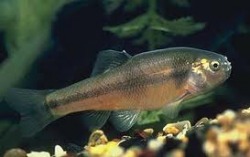
Fathead Minnows, AKA Chubs, Black Heads, or Tuffies, are a fast reproducing, non-game fish, essential for all ponds or lakes. These fish provide food for almost everything in your pond. Fatheads reproduce often, each pair laying 200-500 eggs. They rarely exceed 3" in length and are usually 250 count/pound. These fish should be stocked before the stocking of Bass and continued as often as possible for years to come.
Stocking rates
10-100 Pounds per acre
Stocking rates
10-100 Pounds per acre
Golden Shiners
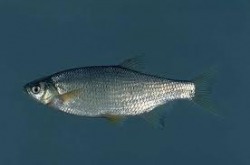
Golden Shiners are another great addition to your pond for growing trophy Bass. You may have heard about Shiners because they are commonly used for bait. Golden Shiners grow up to 10" long, although the average is 6-7". When stocked in the Spring, shiners grow to lengths that by Fall, fingerling Bass cannot yet eat. This gives them ample time to reproduce. By the following year, your shiners will be 4-6" long and your Bass 8-10" long, thus giving the Bass more bang for his buck. Bass may expel a lot of energy chasing prey, so they need to catch something that worth their while to grow. There are approximately 100 2-4" shiners in a pound.
Stocking rates
10-100 pounds per acre
Sizes available spring 2025
Pond run 2-5 inch
Medium 2-3 inch
Large 3-4 inch
X-Large 4-5 inch
Stocking rates
10-100 pounds per acre
Sizes available spring 2025
Pond run 2-5 inch
Medium 2-3 inch
Large 3-4 inch
X-Large 4-5 inch
Grass Carp
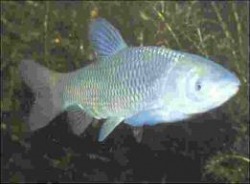
Grass Carp are also known as the Whit Amur. These fish are native to Eastern Asia and were brought to the United States in the 1960's. Grass Carp feed primarily on vegetation that grows in your pond and very seldom prey on other fish. They prefer rooted vegetation near the bank but will eat anything green in your pond. Although we are aware that it is possible for Grass Carp to reproduce naturally in your pond, after 35 years in the fish business, we have never one seen this happen.
Some people ask, well then how do you sell fish that do not reproduce? The waters that Grass Carp were taken from was the warm water rivers of Eastern Asia. Their eggs require days of constant warm, running water to hatch. Female will not lay their eggs in still water. Commercially, the female eggs are collected and mixed with male milt, then put into raceways with warm moving water. These are then put into algae filled ponds to be raised and seined.
Stocking rates
2-25 per acre
Sizes available spring 2025
4-6 inch
7-11 inch
Some people ask, well then how do you sell fish that do not reproduce? The waters that Grass Carp were taken from was the warm water rivers of Eastern Asia. Their eggs require days of constant warm, running water to hatch. Female will not lay their eggs in still water. Commercially, the female eggs are collected and mixed with male milt, then put into raceways with warm moving water. These are then put into algae filled ponds to be raised and seined.
Stocking rates
2-25 per acre
Sizes available spring 2025
4-6 inch
7-11 inch
Koi
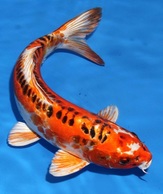
Koi (Cyprinus Carpino) are a native fish to Japan. They are a way of life, much like cats and dogs in America. However, there is one big difference. Often, Koi outlive their owners and are passed down through generations. Recently, a Japanese family was interviewed about their Koi, which has been passed down so many times that the new owners did not know the original owner's names (their great great grandparents). Scientists did a study of some of the fish's scales and found that of the fish was 226 years old.
Koi eats nearly anything in a pond, but commercial food made for Koi is ideal. They can go days or weeks with no food at all, with no harm. Feeding food designed for them on a regular basis helps keep their color and weight ideal.
Koi will reproduce in a variety of ponds, but everything from insects to their own parents will prey on them. Getting a high return in very unlikely. Koi can be stocked in aquariums to large lakes and do well in all. They come in a variety of colors with 100's of patterns- no two Koi are the same. We raise and sell Koi, many of which are Butterfly Koi with many colors. Prices, sizes, and colors vary drastically. Our prices are excellent compared to fish farms that strictly raise Koi.
Sizes available spring 2025
3-4 inch
4-6 inch
6-8 inch
8-10 inch
12-14 inch
16 inch plus
Koi eats nearly anything in a pond, but commercial food made for Koi is ideal. They can go days or weeks with no food at all, with no harm. Feeding food designed for them on a regular basis helps keep their color and weight ideal.
Koi will reproduce in a variety of ponds, but everything from insects to their own parents will prey on them. Getting a high return in very unlikely. Koi can be stocked in aquariums to large lakes and do well in all. They come in a variety of colors with 100's of patterns- no two Koi are the same. We raise and sell Koi, many of which are Butterfly Koi with many colors. Prices, sizes, and colors vary drastically. Our prices are excellent compared to fish farms that strictly raise Koi.
Sizes available spring 2025
3-4 inch
4-6 inch
6-8 inch
8-10 inch
12-14 inch
16 inch plus
Goldfish
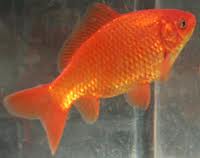
Goldfish (Carassius auratus) differ only in color from the Persian Carp and are the most common aquarium fish in the world. Goldfish are most commonly 3-8" used mainly for bait and aquariums. We do not recommend stocking Goldfish in lakes, although is can benefit your pond's balance by providing extra forage for Bass and Channel Catfish. Goldfish can pose a risk of overpopulating because they reproduce in vast numbers. They are herbaceous, only eating plant life and fish food. We sell several sizes of goldfish by the pound, colors ranging drastically.
Sizes available Spring 2025
Medium 3-4 inch (appx 30 per pound)
Large 4-5 inch (appx 15 per pound)
Xlarge 5-6 inch (appx 7 per pound)
Jumbo 6 inch plus (appx 3 per pound)
Sizes available Spring 2025
Medium 3-4 inch (appx 30 per pound)
Large 4-5 inch (appx 15 per pound)
Xlarge 5-6 inch (appx 7 per pound)
Jumbo 6 inch plus (appx 3 per pound)
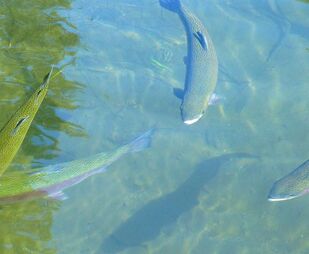
Rainbow Trout
Rainbow Trout (Oncorhynchus mykiss) are known to live in cold, freshwater streams but are encouraged to be placed in lakes and ponds. Although water temperate greater than 74 F is proven fatal to this species. There are still many benefits to stocking.
Most fish we stock slow down greatly during the cold weather and prove difficult to catch. Trout however are aggressive and easy to catch during the winter months. We recommend stocking 50-100 pounds per acre in October when water temps are under 70. Fish that are not caught and eaten will die and breakdown and provide excellent fertilizer for your pond. Trout are the most nutrient rich fish that can be stocked in ponds, any fish that are eaten by "10 pound bass" are excellent forage.
Sizes available Fall 2025
Forage (3-7 Inch)
Stockers (8-12 Inch)
Catchable (12-14 Inches)
Lunkers (14 Inch Plus)
Note that in normal farm pond conditions these fish will die come late spring early summers, so keep all that you catch.
Rainbow Trout (Oncorhynchus mykiss) are known to live in cold, freshwater streams but are encouraged to be placed in lakes and ponds. Although water temperate greater than 74 F is proven fatal to this species. There are still many benefits to stocking.
Most fish we stock slow down greatly during the cold weather and prove difficult to catch. Trout however are aggressive and easy to catch during the winter months. We recommend stocking 50-100 pounds per acre in October when water temps are under 70. Fish that are not caught and eaten will die and breakdown and provide excellent fertilizer for your pond. Trout are the most nutrient rich fish that can be stocked in ponds, any fish that are eaten by "10 pound bass" are excellent forage.
Sizes available Fall 2025
Forage (3-7 Inch)
Stockers (8-12 Inch)
Catchable (12-14 Inches)
Lunkers (14 Inch Plus)
Note that in normal farm pond conditions these fish will die come late spring early summers, so keep all that you catch.
How should I stock my lake?
(Numbers based on a 1 acre body of water)
-------------------------------------------------------------------------
POND 1 (BASS POND)
FIRST STOCKING (SPRING)
10 POUNDS FATHEAD MINNOWS
5 POUNDS GOLDEN SHINERS
400 REGULAR BLUEGILL
100 REDEAR SUNFISH
2ND STOCKING (FALL)
100 LARGEMOUTH BASS
100 HYBRID BLUEGILL (OPTIONAL)
100 CHANNEL CATFISH (OPTIONAL)
-------------------------------------------------------------------------
POND 2 (CATFISH POND)
SPRING OR FALL
10 POUNDS FATHEAD MINNOWS
5 POUNDS GOLDEN SHINERS
300-1000 CHANNEL CATFISH
100 REDEAR SUNFISH
100 REGULAR BLUEGILL
100-500 HYBRID BLUEGILL (OPTIONAL)
-------------------------------------------------------------------------
POND 3 (CRAPPIE POND)
1ST STOCKING (SPRING)
15 POUNDS FATHEAD MINNOWS
100 REDEAR
100 REGULAR BLUEGILL
2ND STOCKING (FALL)
100 CRAPPIE
100-500 HYBRID BLUEGILL
5 POUNDS GOLDEN SHINERS
-------------------------------------------------------------------------
POND 4 (WALLEYE POND)
1ST STOCKING (SPRING)
20 POUNDS FATHEAD MINNOWS
10 POUNDS GOLDEN SHINERS
250 YELLOW PERCH
100 REDEAR
100 REGULAR BLUEGILL
2ND STOCKING (FALL)
100 WALLEYE
10 POUNDS MINNOWS
-------------------------------------------------------------------------
Please give us a call; we would love to give you a bid on stocking your lake. We will almost always have a better price on the same fish as anyone.
NOT ALL FISH SIZES ARE CREATED EQUAL
2 in. Hybrid Bluegill---5 pounds per1000
3 in. Hybrid Bluegill---17.2 pounds per 1000
4 in. Hybrid Bluegill---41.4 pounds per 1000
5in. Hybrid Bluegill---82.4 pounds per 1000
A 3 inch fish is over 3 times as big as a 2 inch fish
Remember that size matters. Most fish farms grade their fish and set their pricing by weight. This means that when we seine fish and bring them to our holding tanks, we have graders(floating boxes that have bars spaced out evenly) that we place the fish in to sort the sizes and then count 1000 of each size. This gives us our weight count and determines where we set our price. A chart has been developed to size fish based on average weight.
FOR EXAMPLE:
If we seine 2 year old Hybrid Bluegill, there will be fish ranging from 2-6 inches in a pond. Although these fish are the same age, they do not grow at the same rate and will be graded 3 times.
We place our fish into the grader box for a few minutes and allow the smallest to swim out. This gives us fish that weigh roughly 20 pounds per 1000. Our chart tells us that a 2 inch hybrid bluegill weighs 5 pounds per 1000 and a 3 inch hybrid bluegill weighs 17.2 pounds per 1000.
(Numbers based on a 1 acre body of water)
-------------------------------------------------------------------------
POND 1 (BASS POND)
FIRST STOCKING (SPRING)
10 POUNDS FATHEAD MINNOWS
5 POUNDS GOLDEN SHINERS
400 REGULAR BLUEGILL
100 REDEAR SUNFISH
2ND STOCKING (FALL)
100 LARGEMOUTH BASS
100 HYBRID BLUEGILL (OPTIONAL)
100 CHANNEL CATFISH (OPTIONAL)
-------------------------------------------------------------------------
POND 2 (CATFISH POND)
SPRING OR FALL
10 POUNDS FATHEAD MINNOWS
5 POUNDS GOLDEN SHINERS
300-1000 CHANNEL CATFISH
100 REDEAR SUNFISH
100 REGULAR BLUEGILL
100-500 HYBRID BLUEGILL (OPTIONAL)
-------------------------------------------------------------------------
POND 3 (CRAPPIE POND)
1ST STOCKING (SPRING)
15 POUNDS FATHEAD MINNOWS
100 REDEAR
100 REGULAR BLUEGILL
2ND STOCKING (FALL)
100 CRAPPIE
100-500 HYBRID BLUEGILL
5 POUNDS GOLDEN SHINERS
-------------------------------------------------------------------------
POND 4 (WALLEYE POND)
1ST STOCKING (SPRING)
20 POUNDS FATHEAD MINNOWS
10 POUNDS GOLDEN SHINERS
250 YELLOW PERCH
100 REDEAR
100 REGULAR BLUEGILL
2ND STOCKING (FALL)
100 WALLEYE
10 POUNDS MINNOWS
-------------------------------------------------------------------------
Please give us a call; we would love to give you a bid on stocking your lake. We will almost always have a better price on the same fish as anyone.
NOT ALL FISH SIZES ARE CREATED EQUAL
2 in. Hybrid Bluegill---5 pounds per1000
3 in. Hybrid Bluegill---17.2 pounds per 1000
4 in. Hybrid Bluegill---41.4 pounds per 1000
5in. Hybrid Bluegill---82.4 pounds per 1000
A 3 inch fish is over 3 times as big as a 2 inch fish
Remember that size matters. Most fish farms grade their fish and set their pricing by weight. This means that when we seine fish and bring them to our holding tanks, we have graders(floating boxes that have bars spaced out evenly) that we place the fish in to sort the sizes and then count 1000 of each size. This gives us our weight count and determines where we set our price. A chart has been developed to size fish based on average weight.
FOR EXAMPLE:
If we seine 2 year old Hybrid Bluegill, there will be fish ranging from 2-6 inches in a pond. Although these fish are the same age, they do not grow at the same rate and will be graded 3 times.
We place our fish into the grader box for a few minutes and allow the smallest to swim out. This gives us fish that weigh roughly 20 pounds per 1000. Our chart tells us that a 2 inch hybrid bluegill weighs 5 pounds per 1000 and a 3 inch hybrid bluegill weighs 17.2 pounds per 1000.
